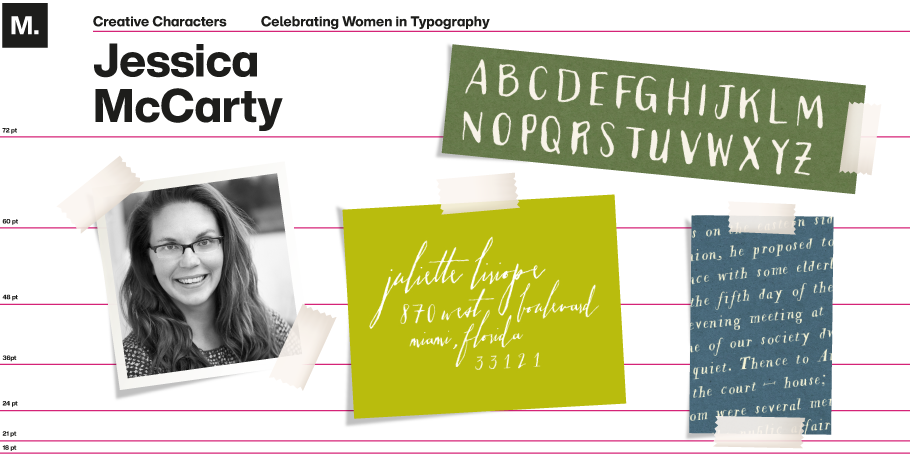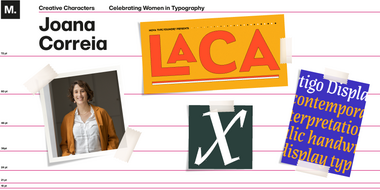Celebrating Women in Typography: Jessica McCarty

March is Women’s History Month, so we’re taking the opportunity to celebrate some amazing women working in the type design industry.
This week, we’re talking with Jessica McCarty about her journey as a type designer and her insights for new designers.
MyFonts: Tell us about your journey as a type designer and any challenges you had to overcome. What would be one tip that you will give other women who are considering becoming a type designer?
Jessica McCarty: The first thing people should know about me is that I’m a bit of a dinosaur! I’m self-taught — in FontLab Studio 5! — and released my first fonts around the same time Instagram launched. Over the years I’ve seen a lot of changes in our industry.
The change that excites me most is the recent democratization of marketplaces, tools, and customers. It’s now possible to pursue this career from almost anywhere in the world, with or without a formal education. This is a GREAT thing in my opinion — with a bit of grit and a computer, women can carve out a typographic path on their own terms.
That said, there are still challenges unique to type designers who identify as women. Thanks to the work of countless advocates across the industry, the frequency of #MeToo moments is decreasing. In many ways, however, our skills and capabilities remain underestimated. This “soft sexism” pervades technical trades — typography is no exception.
I’ll never forget overhearing a conversation a few years ago in which hand drawn calligraphy scripts were derided for being “way too feminine and girly,” and “so much easier to make than a workhorse sans.” As the conversation continued it was apparent that the participants were implying that design-fluency, programming ability, and customer buying power were gender-based. WHAT?!
It’s at this point I should mention that I’m co-founder of an entirely woman-owned and operated type foundry that specializes in modern calligraphy fonts. Our collection is marketed to entrepreneurs in the wedding industry, many of whom also identify as women.
And this leads me to my biggest tip for women considering a career in type design: try to approach your challenges as opportunities. The designers who sneered at calligraphy scripts? Apparently they weren’t aware of or interested in meeting the typographic needs of the 315,000+ active wedding businesses who collectively serve a $75 billion recession-proof industry. (Insert your favorite ascii shrug here.) As for designers who don’t discriminate? They have a market advantage — and fantastically kind, design-fluent customers too.
“The right thing” for someone else may not be right for you. It’s easy to get discouraged but try your best to ignore the haters, and focus on developing your own customer base & professional networks. Extend bridges and ladders to others, then help the people on the other side join you. By working together to support one another, we forge a gender equal world.
Hmm, I guess that’s more than one tip!
MF: Can you share some insights on what more can be done to progress diversity in typography?
JM: This is a really important question.
If we really want to progress diversity in typography, we need to first accept that there are many valid typographic paths, not just those prescribed by historical/colonial patterns and systems. There are a plurality of practices and practitioners existing today — everyone is welcome.
We also need to acknowledge the very real roadblocks that prevent people from accessing employment, professional travel and development, and/or formal education: Namely financial considerations, visa access, and the MANY gatekeeping biases in our industry.
Lastly, we need to act on these barriers to entry. Larger organizations have the power to make major changes by providing scholarships, resources, and financial support to under-represented communities. Individuals have more agility. Consider volunteering to teach a typography workshop in your local school system. Reach out to other designers directly and welcome them to your next online meetup. Don’t have a regular online meetup? Start one!
Each of us has a responsibility to make space for others at the typographic table. Here are a few recent initiatives making a difference and pulling up chairs:
The Alphabettes Mentorship Program has done a fantastic job of connecting mentors and mentees across the world. Anyone can sign up, no matter where they live or how long they’ve been in type.
Sharp Type established and funds The Malee Scholarship, which promotes inclusivity by directly empowering young women of color wishing to expand their typographic skills & pursue their ambitions.
Juan Villanueva recently launched Type Crit Crew, a free multilingual resource for type design students to meet one-on-one with experienced designers for virtual critiques. He has also established the Display Type BIPOC Fund, an ongoing scholarship for aspiring BIPOC designers who wish to attend Type@Cooper.
TypeThursday, a monthly typographic meetup, is now connecting letterform lovers from around the world in online sessions. Chapters stretch across the Americas and Europe.
ATypI is adapting their in-person typographic conference to a hybrid online event, as well as offering monthly online hangouts. This is a great way to connect with other designers and learn new skillsets.
TypeWknd is an online-only, free typographic conference for everyone who sees, draws, makes, studies, or sells type. The conference features global topics and perspectives. Last year’s talks are available free of charge on their Youtube channel. (Full disclosure: I’m a TypeWknd co-founder.)
MF: So you mentioned that you yourself are self-taught.
JM: Yes, my creative journey has definitely been more of a lazy river than a traditional path — no design school for me, unless you count the School of Hard Knocks! I used to think this was a rare thing, but over the years I’ve met so many type designers who started their careers in fields totally unrelated to typography. The siren song eventually reaches us all!
Initially I studied marine biology, but ended up graduating with a BFA in cinema & photography. (And a bunch of student loans.) When it comes to type, I’m entirely self-taught via trial & error. Mostly error.
MF: We do hear that a lot! So in your case, then, when did you get into type design?
JM: I guess it’s time for one of those lazy river stories, haha!
It took me more than 10 years of meandering to find my way to type. My day job after graduation was frustrating. I started moonlighting in the evenings as a graphic designer in an effort to reclaim my mental health. Around 2010, I was approached by a couple who wanted an invitation with “messy but modern calligraphy.” Hiring a calligrapher wasn’t possible because they wanted to use that same writing style throughout the entire wedding and in their first years together as newlyweds. No problem, we could just find a font, right?
Actually, we couldn’t! What they wanted didn’t exist in the marketplace at that time.
Not wanting to ask them to compromise their vision, I figured, “OK, I can just make a font for them! How hard could it be?” (Famous last words of every type designer!)
It was actually REALLY hard, as I found out. But the client loved the end result and I loved the design process. Emily Lime & Laura Worthington released some of their first retail calligraphy typefaces around the same time as this project, and seeing their commercial success was really inspiring. I applied to become a MyFonts foundry, and the rest was history! Just 12 months later I was able to quit my stressful day job and focus solely on type design.
MF: What do you do besides type? Can you share a fun fact about yourself?
JM: When I’m not inside sketching or debugging, I can usually be found outside chasing chickens or picking apples. My husband and I have an organic farm where we raise heirloom fruits, vegetables, and free-range eggs. It keeps us on our toes!


